Nano-silica modified lightweight and high-toughness carbon fiber/phenolic ablator with excellent thermal insulation and ablation performance
Wenjie Xu , Wend Song , Xinfeng Ji , Cheng M , Jitong Wng ,Wenming Qio ,**, Liheng Ling
a State Key Laboratory of Chemical Engineering, East China University of Science and Technology, Shanghai 200237, China
b School of Chemical Engineering and Materials, Changzhou Institute of Technology, Changzhou 213032, China
c Key Laboratory of Specially Functional Polymeric Materials and Related Technology(Ministry of Education),School of Materials Science and Engineering,East China University of Science and Technology, Shanghai 200237, China
Keywords: Nano-silica Carbon fiber Phenolic aerogel Insulation Ablation
ABSTRACT Lightweight and high-toughness carbon fiber/phenolic ablator (CFPA) is required as the Thermal Protection System (TPS) material of aerospace vehicles for next-generation space missions.To improve the ablative properties, silica sol with good particle size distribution prepared using tetramethoxysilane(TMOS) was blended with natural rubber latex and deposited onto carbon fiber felt, which was then integrated with phenolic aerogel matrix, introducing nano-silica into the framework of CFPA.The modified CFPA with a low density of 0.28-0.31 g/cm3 exhibits strain-in-fracture as high as 31.2% and thermal conductivity as low as 0.054 W/(m·K).Furthermore, a trace amount of nano-silica could effectively protect CFPA from erosion of oxidizing atmosphere in different high-temperature environments.The oxyacetylene ablation test of 3000 °C for 20 s shows a mass ablation rate of 0.0225 g/s, a linear ablation rate of 0.209 mm/s for the modified CFPA, which are 9.64% and 24.82% lower than the unmodified one.Besides, the long-time butane ablation test of 1200 °C for 200 s shows an insignificant recession with mass and linear ablation rate of 0.079 g/s and 0.039 mm/s,16.84%and 13.33%lower than the unmodified one.Meanwhile, the fixed thermocouple in the test also demonstrates a good thermal insulation performance with a low peak back-face temperature of 207.7 °C,12.25% lower than the unmodified one.Therefore, the nano-silica modified CFPA with excellent overall performance presents promising prospects in high-temperature aerospace applications.
1.Introduction
Hypersonic aerospace vehicles experience extreme aerodynamic heating environments during their re-entry through the atmosphere.To guarantee secure operation, Thermal Protection System(TPS)materials are essential to provide heat shielding for a spacecraft’s surface and internal structure [1,2].As an advanced Lightweight Ceramic Ablator (LCA) developed by NASA’s Ames Research Center, phenolic impregnated carbon ablator (PICA) possesses a lightweight nature,excellent thermal insulative properties,and good ablative properties [3-6], and has been selected and applied as an ablative TPS material in successful NASA missions,including the Stardust and the Mars Science Laboratory[7,8].In the past several decades,flexible TPS materials have widely aroused the attention of researchers,because they have higher strain-to-failure and can be utilized as larger heatshield without additional manpower costs and gap fillers[9-11].NASA endeavored to change the matrix and/or the reinforcement of PICA to fabricate PICA flex,which underwent strain of 8%-12% before showing necking behavior in compressing tests[12].Recently,Song et al.managed to adjust the interfacial bonding of PICA by depositing a uniform natural rubber coating onto the carbon fiber felt through ambient pressure impregnation,realizing a high fracture strain of 39.6%[13].Nevertheless,to the best of our knowledge,the fabrication of PICA materials with both high toughness and excellent ablative properties, which are the growing requirements of next-generation space missions, remains a challenging task.
A significant recession of the TPS materials due to the ablation process in the re-entry flight might put the flight stability of a spacecraft at risk.Current ways of improving the ablative properties of PICA materials are focused on the modification of the phenolic matrix and the carbon fiber fabric reinforcement to reduce matrix pyrolysis and fiber loss.A variety of fillers have been exploited to enhance the network of the phenolic matrix through the co-precursor method,such as carbon nanotubes[14],graphene or graphene oxide [15], ceramic [16,17], and organic silicone [18],realizing better thermal stability and higher residual weight.Besides, researchers also introduce ceramic coatings with a low diffusion coefficient of oxygen onto the surface of carbon fibers,so as to improve their oxidation resistance and reduce their surface setback in a high-temperature oxidizing environment [19,20].However,there is often a large difference in the thermal expansion coefficient between carbon fibers and ceramic coating,which leads to their separation from each other at high temperature, resulting in poor mechanical and thermal protection properties of the composite.
Nano-silica exhibits an excellent nanometer effect and has been widely employed as a ceramic nanofiller [21,22].It can be used for modifying the matrix of composites to fabricate PICA materials with excellent oxidation resistance.At high temperature, the nano-silica in the matrix will be molted and get attached to the surface of carbon fibers,and significantly reduce their oxidation rate by insulating them from the oxidating atmosphere in the ablation[23-26].More importantly, it can also serve as a ceramic coating by treating the surface of composites with silica sol prepared through the sol-gel method [27-29].The silica sol can be homogeneously blended with natural rubber latex[30],which is a low-cost natural polymeric compound suitable for bonding with carbon fiber despite different thermal expansion coefficients[13],for surface modification.
Herein, a novel nano-silica modified lightweight and hightoughness carbon fiber/phenolic ablator (CFPA)with excellent ablative properties is fabricated through the modification of the carbon fiber felt with a silica sol/natural rubber coating.Silica sol was prepared using tetramethoxysilane (TMOS) and then blended with natural rubber latex.Afterwards, a silica sol/natural rubber coating was deposited onto the surface of carbon fiber felt,which was then combined with a phenolic aerogel matrix.The effect of nano-silica on the micromorphology, mechanical properties,thermal stability, and thermal conductivity of CFPA was systematically studied.The ablative properties of CFPA in different high-temperature environments were evaluated by the oxyacetylene ablation test and the long-time butane ablation test respectively.The introduced nano-silica can protect CFPA from erosion of oxidizing atmosphere, assuring excellent ablative properties, which are of great significance for the practical application of TPS materials.
2.Experimental
2.1.Preparation of silica sol
The silica sol was prepared according to the previous report with some modifications [31].TMOS was diluted in methanol with a volume ratio of 3:1.Then, the diluted TMOS was hydrolyzed in the mixture of ammonia, deionized water, and methanol (the mass fraction of ammonia and deionized water was 1 wt% and 15 wt%,respectively) with a volume ratio of 1: 9, and stirred to prepare the silica sol.After that, distillation was carried out to get rid of the methanol and obtain the final product with a solid content of 30 wt%.
2.2.Preparation of silica sol/natural rubber modified carbon fiber felt
Silica sol and commercial natural rubber latex were mixed with the deionized water to prepare different blend solutions.The mass fraction of the natural rubber latex was 2 wt%and the mass fraction of silica sol was 1 wt%, 2 wt%, and 3 wt%, respectively.PAN-based carbon fiber felts with a size of 150 mm × 150 mm × 10 mm were then immersed with different blend solutions.After being treated for 20 min with ultrasound,the carbon fiber felts were dried at room temperature for 1 day, and then at 80°C in an oven for 1 day.Thus,silica sol/natural rubber modified carbon fiber felts were prepared.
2.3.Fabrication of CFPA/SS
Phenolic resin (PR) and hexamethylenetetramine (HMTA) were dissolved in the isopropanol to prepare the PR solution.The mass fraction of PR was 15 wt%,and the mass ratio of PR:HMTA was 6:1.The silica sol/natural rubber modified carbon fiber felt was then put into a self-designed mold and fully impregnated with the asprepared PR solution under ambient conditions.Afterwards, the mold was sealed and put into an air-circular oven at 80°C.After 3 days,the sample was taken out and dried at room temperature for 1 day,at 80°C for 1 day,and eventually at 180°C for 6 h under vacuum.Thus, CFPA/SS samples were prepared and denoted as CFPA/SS-x,where x is the mass fraction of the silica sol in the blend solution.
2.4.Characterization
The morphology of the CFPAs was observed using a scanning electron microscope (SEM, FEI NOVA Nano SEM450).The morphology of nano-silica in the silica sol was observed using a transmission electron microscope (TEM, JEOL 2100F).The particle size distribution of nano-silica was characterized using a laser scatter particle size and zeta potential analyzer (Zetasizer Nano ZS90).The three-point bending test was conducted using an electronic universal testing machine (Instron 3367) with samples with a size of 150 mm×20 mm×10 mm.The value of flexural strength,flexural modulus and fracture strain was the average of five tests.Thermogravimetric (TG) analysis was carried out using a gravimetric analyzer(TGA 8000)from room temperature to 800°C at a heating rate of 10°C/min in an air atmosphere.The thermal conductivity was measured at room temperature with heat flux method (Netzsch HFM436)with samples with a size of 150 mm×150 mm×10 mm.The oxyacetylene ablation test was performed to evaluate the ablation rates using an oxyacetylene flame torch of 3000°C for 20 s.The samples were made into cylinders with a diameter of 3 cm.The value of the ablation rates was the average of five tests.The long-term butane ablation test was performed to evaluate the ablation rates and the back-face temperature using a butane flame torch of 1200°C for 200 s.One K-type thermocouple was fitted at the center of the back surface of the samples to measure the back-face temperature.The value of the ablation rates was the average of five tests.
3.Results and discussion
3.1.Preparation
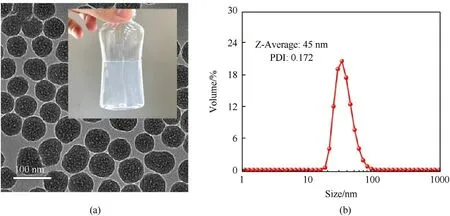
Fig.1.(a) TEM photograph and digital photograph of the silica sol; (b) Particle size distribution of nano-silica in the silica sol.
The silica sol in this work was prepared using TMOS through the sol-gel method.As is shown in Fig.1(a), the spherical nano-silica particles produced through condensation reaction are evenly dispersed in deionized water, indicating that they can serve as a protective coating for the carbon fibers in the ablation.Additionally,no notable agglomerates can be observed,ensuring that there is no stress concentration when the composite is subject to external forces, which is likely to lead to poor mechanical behaviors.Moreover, according to the result of laser scatter particle size analysis in Fig.1(b), the nano-silica particles have a narrow particle size distribution(PDI:0.172)and a relatively small average size(45 nm),which is favorable to their enforcement effect on the natural rubber[32,33],contributing to good mechanical properties of CFPA.
The as-prepared silica sol was then homogeneously blended with natural rubber latex owing to its excellent dispersion, therefore the natural rubber coating could serve as the matrix and integrate nano-silica into the composites.The fabrication process of CFPA/SS is illustrated in Fig.2(a).After impregnating the carbon fiber felt with the blend solution and drying, a silica sol/natural rubber coating can be deposited onto the carbon fiber felt, so that the nano-silica particles are introduced into the framework of CFPA.Afterwards,the modified carbon fiber felt is combined with the PR solution through ambient pressure impregnation, obtaining the CFPA/SS after sol-gel reaction and drying.Fig.2(b) shows the photograph of CFPA/SS-2.It can be seen that the yellow phenolic aerogels are distributed between the black carbon fibers,which is a typical macro morphology for CFPA.
3.2.Micromorphology
To further investigate the impact of introduced nano-silica on the microstructure of the CFPA, SEM measurements were performed.As shown in Fig.3(a) that the surface of the modified carbon fibers is covered with a silica sol/natural rubber coating,and there is also silica sol/natural rubber bonded between carbon fibers at different joints.These microscopic morphology characteristics are generally the same as that of the carbon fiber felt modified with pure natural rubber latex (Fig.3(b)).Meanwhile, as is shown in Fig.3(c), nano-silica is successfully introduced onto the surface of carbon fibers through natural rubber coatings.Therefore, the introduction of nano-silica has no evident impact on the distribution of natural rubber on the surface of carbon fibers or between carbon fibers, which are beneficial for the ability of CFPA/SS of responding to external forces [13].
The SEM photographs of the CFPA/SS samples and the aerogel in the composites are shown in Fig.4, respectively.As is shown,samples with different mass fractions of silica sol share similar micromorphology.After the sol-gel reaction, the aerogel matrix and the carbon fiber felt reinforcement combine well, while the gaps between carbon fibers are filled by the aerogel.Besides, the aerogel is endowed with a highly porous structure,contributing to both the low density and low thermal conductivity of CFPA/SS.
3.3.Mechanical properties
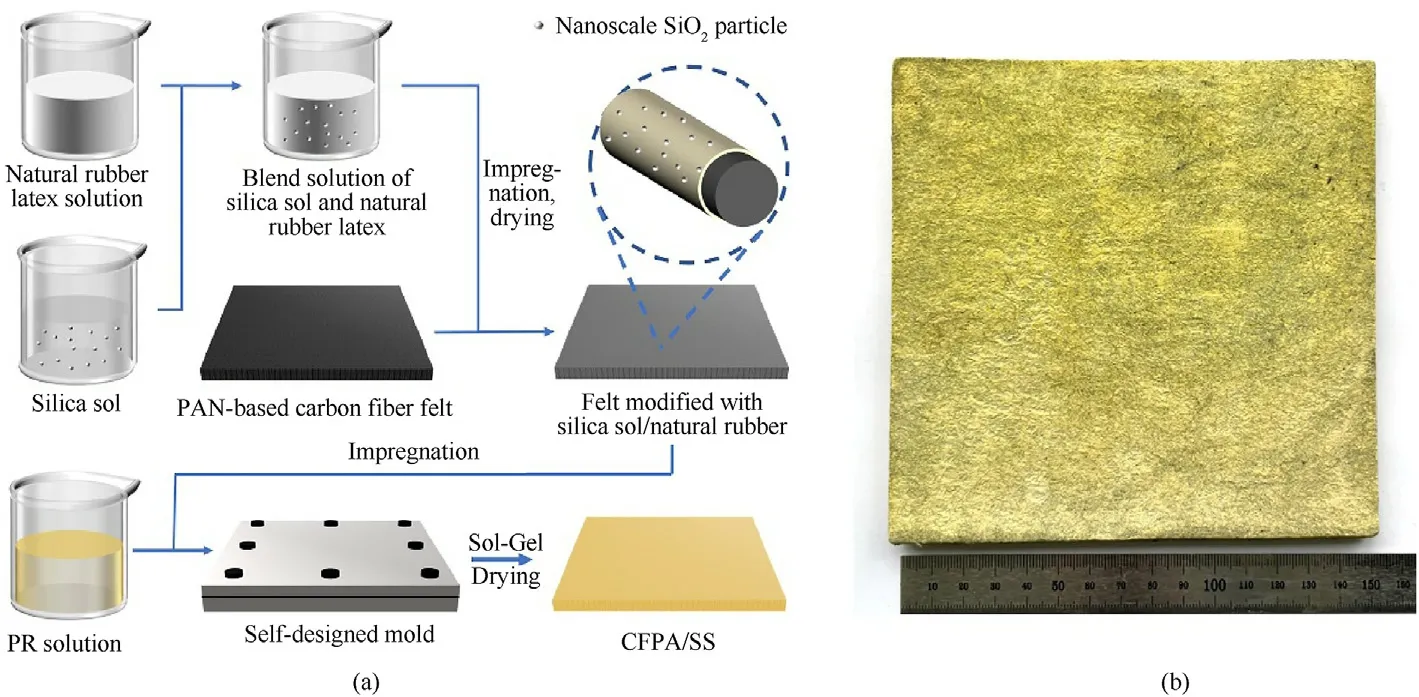
Fig.2.(a) Schematic illustration of the fabrication of CFPA/SS; (b) Digital photograph of CFPA/SS-2.
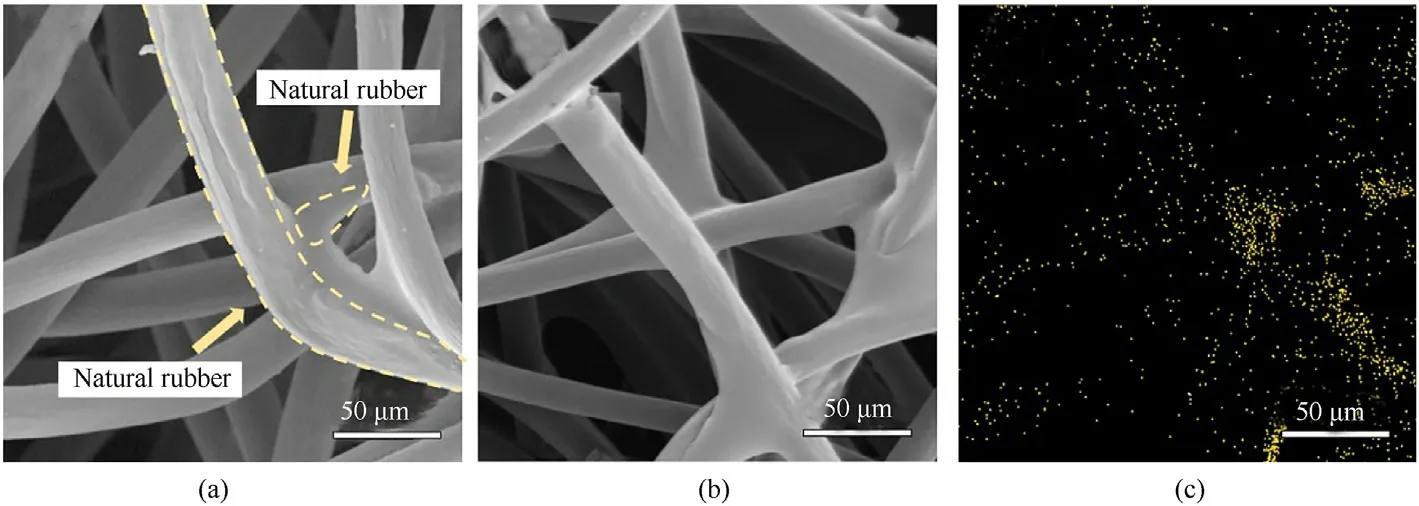
Fig.3.Micromorphology of carbon fiber felt modified with (a) silica sol/natural rubber,(b) pure natural rubber, (c)Si-mapping image of carbon fiber felt modified with silica sol/natural rubber.
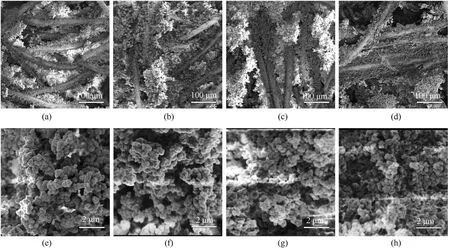
Fig.4.Micromorphology of(a) CFPA/SS-0, (b) CFPA/SS-1,(c) CFPA/SS-2, (d) CFPA/SS-3, and aerogel micromorphology of (e) CFPA/SS-0, (f) CFPA/SS-1, (g) CFPA/SS-2, (h) CFPA/SS-3.
The toughness of TPS materials is entailed by the nextgeneration hypersonic aerospace vehicles to fabricate larger heatshields and get rid of the need for additional manpower costs and compatible gap fillers.The three-point bending test was conducted to evaluate the flexural properties of CFPA/SS samples.As shown in Fig.5, all the bending stress-strain curves follow the same twostage pattern.In the initial stage, the stress rises linearly as the bending strain increases,suggesting that elastic deformation takes place.After reaching the peak,the stress decreases gradually,while the samples yield and break irreversibly [34].Despite the introduction of nano-silica,natural rubber still does well in transferring the stresses as the interface layer between the phenolic aerogel matrix and the carbon fiber felt reinforcement [13], assuring the good toughness of CFPA/SS.
The detailed results of the test are presented in Table 1.With the increasing mass fraction of silica sol,the density of CFPA/SS samples ranges from 0.28 g/cm3to 0.31 g/cm3without large changes.In comparison,the fracture strain of CFPA/SS-1 rises sharply to 31.16%,which is much higher than that of CFPA/SS-0 (25.4%).This is primarily due to a small amount of nano-silica can remarkably increase the strength of natural rubber through the nanoreinforcement effect [35-37], which improves the capacity of the natural rubber coating to transmit stress when subjected to external forces, realizing better toughness of the composite.Nevertheless, with the increment in the mass fraction of silica sol from 1 wt% to 3 wt%, the fracture strain descends from 31.2% to 13.9%, suggesting a higher mass fraction of silica sol will lead to a lower fracture strain.The probable reason is that silica sol with a higher mass fraction results in the agglomeration of nano-silica in the natural rubber(Fig.S1),which causes stress concentration and reduces the mechanical properties of the composite [35].But it should be stressed that the fracture strain of CFPA/SS samples are all much higher than that of PICA flex (12%) [12], indicating that they maintain high toughness.In addition,it is also noticeable that a slight decrease takes place in the flexural strength of CFPA/SS samples compared with CFPA/SS-0.Consequently, in practical applications where high strain-to-failure is required for TPS materials,nano-silica modified CFPA has advantages.
3.4.Thermal stability
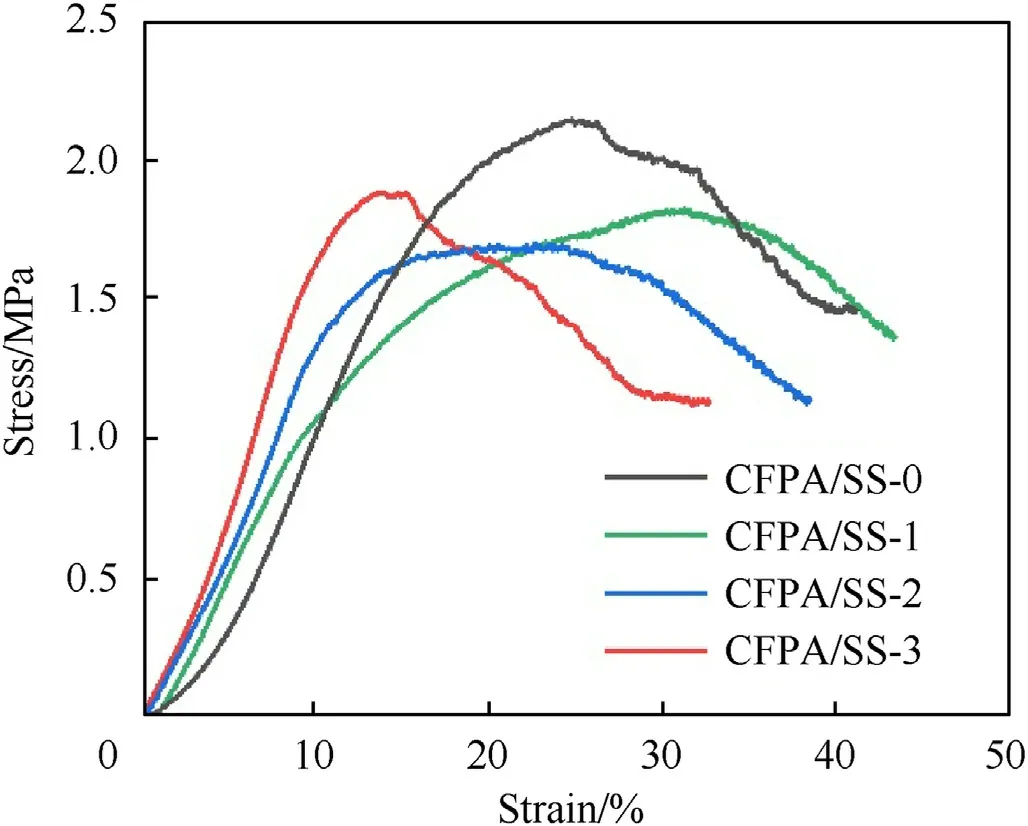
Fig.5.Flexural stress-strain curves of CFPA/SS samples.
The thermal stability of CFPA/SS samples in an air atmosphere was studied by TG analysis from room temperature to 800°C at a heating rate of 10°C/min.As illustrated in Fig.6(a), the thermal decomposition process of all the samples can be divided into three stages.From room temperature to 150°C,there is little weight loss due to the volatilization of aliphatic amines and water [38],revealing good thermal stability.When the pyrolysis temperature continues to rise to 730°C,it can be seen that the modified samples have a higher weight loss.The probable reason is that the relatively high thermal conductivity of nano-silica(1.4 W/(m·K))accelerates the hydrolyzation and combustion of components in the composite, especially the natural rubber coating.On the contrary, after pyrolysis temperature exceeding 730°C,the sample modified with a higher mass fraction of silica sol shows a higher residual weight,which demonstrates the improvement of silica sol modification on the thermal stability of the composites begin to take.This can be attributed to the introduced nano-silica, which remains on the surface of the carbon fibers even after the hydrolyzation and combustion of the natural rubber coating,so that it can protect the carbon fibers against the erosion of the oxidizing atmosphere at high temperature and reduce their weight loss.Moreover, as the mass fraction increases, the residual weight of CFPA/SS at 800°C increases by 54.40%, from 13.45 wt% of CFPA/SS-0 to 20.78 wt% of CFPA/SS-3, indicating that the presence of nano-silica can greatly enhance the thermal stability of the CFPA in a high-temperature oxidizing atmosphere, which contributes to better thermal protection performance.
3.5.Thermal conductivity
The thermal conductivity of CFPA/SS samples was characterized with the heat flux method.In general, the total thermal conductivity of CFPA is the result of three mechanisms of heat transfer at high temperature: solid heat transfer through particles and gas heat transfer inside pores and radiation heat transfer [39].As illustrated in Fig.6(b), the aerogels wrapping the carbon fiber felt limit the heat transfer with its nearly infinite paths and interfaces[40], endowing CFPA/SS-0 with a low thermal conductivity of 0.053 W/(m·K).Furthermore, compared with CFPA/SS-0, the modified samples are slightly more thermally conductive.This is because, with a relatively high thermal conductivity, nano-silica greatly contributes to the solid heat transfer in the natural rubber coating, enhancing the thermal conductivity of CFPA/SS.With the increment in the mass fraction of silica sol from 1 wt%to 3 wt%,the thermal conductivity of the composite rises slowly from 0.054 W/(m·K)to 0.064 W/(m·K).But it is still significantly lower than that of most CFPAs as TPS materials in other works[4,5,18].Therefore,in terms of thermal insulation performance,the nano-silica modified CFPA is a good candidate as TPS material.
3.6.Ablative properties
The ablative properties of TPS materials in an extremely hightemperature environment are of vital importance for both the economical design and secure operation of hypersonic aerospace vehicles.The ablation resistance performance of CFPA/SS samples in an extremely high-temperature environment was evaluated in an oxyacetylene flame at 3000°C for 20 s.As shown in Table 2, a gradual decrease has been witnessed in both the mass ablation rate and linear ablation rate of CFPA/SS samples, reaching 0.0225 g/s and 0.209 mm/s of CFPA/SS-3, 9.64% and 24.82% lower than CFPA/SS-0 (0.0249 g/s and 0.278 mm/s).Apparently, modified samples have lower weight loss and surface setback.This is mainly ascribed to the presence of a trace amount of nano-silica,which can prevent the carbon fibers in the ablation and reduce the recession with its low diffusion coefficient of oxygen.As a result, more introduced nano-silica means a better capacity to protect the carbon fibersfrom oxidating environments, allowing excellent ablation performance.Therefore, in practical applications that emphasize the ablative properties of TPS material,CFPA/SS modified with a higher mass fraction of silica sol is favored.

Table 1Density and flexural properties of CFPA/SS samples.

Fig.6.(a) Thermogravimetric curves of CFPA/SS samples in air atmosphere; (b) Room-temperature thermal conductivities of CFPA/SS samples.

Table 2Ablation rates of CFPA/SS samples in the oxyacetylene ablation test.
The photographs of CFPA/SS-1, CFPA/SS-2, and CFPA/SS-3 after oxyacetylene ablation are shown in Fig.7, which is consistent with the results of the oxyacetylene ablation test.After ablation, the surface of the samples turns black, and a shallow circular pit takes shape.The structure of the samples remains integrated without observable fractures, indicating that after the ablation CFPA/SS succeeds to maintain its good mechanical properties.More importantly,with the increment in the mass fraction of silica sol,it is notable that the pits on the surface of samples after ablation become shallower to some extent, corresponding with the improvements in the ablation rates of the CFPA/SS.
From the cross-sectional photograph of CFPA/SS-2(Fig.S2),it can be seen that the after-ablation sample can be divided lengthwise into three distinct regions:the ablated layer,the carbonized layer,and the original material layer.In the ablated layer,a majority of the phenolic resin aerogel and carbon fibers were consumed to take away the heat,resulting in the formation of the pit.As for the carbonized layer,the phenolic resin aerogel was heated and turned into black carbonaerogel, which can reduce radiation heat transfer and contribute to the thermal insulation performance of the composite.Besides,benefiting from the thermal protection mechanism provided by both the ablated layer and the carbonized layer,the original material layer is not affected by the extremely high-temperature environment,maintaining the original morphology of CFPA/SS.

Table 3Ablation rates of CFPA/SS samples in the long-time butane ablation test.
To further illustrate the effect of introduced nano-silica on the ablation process of CFPA, a schematic illustration of the CFPA/SS with varying degrees of ablation is presented in Fig.8(a).In the beginning,the phenolic aerogel filling the gaps between the carbon fibers is heated and cracked in the ablation, generating carbon aerogel.Then,due to the erosion of high-temperature airflow,most of the carbon aerogel is consumed,leaving only a small amount of them attached to the carbon fiber, while the silica sol/natural rubber coating also remains adhesive to the surface of the carbon fibers instead of being stripped from it.As the ablation continues,the carbon fibers and the natural rubber coating undergo oxidation and combustion at high temperature, which are gradually consumed.At the same time,the nano-silica particles in the natural rubber coating can protect carbon fibers from contacting the hightemperature oxidizing environment, thereby maintaining the structural integrity and improving the ablation performance of the CFPA/SS samples.Fig.8(b)-8(e)show SEM photographs of the CFPA/SS-2 sample with varying degrees of ablation.The changes in the morphology of the CFPA/SS-2 sample are consistent with the schematic illustration discussed above.Therefore, it can be concluded that the introduction of nano-silica can effectively improve the ablation performance of CFPA in an oxidating environment with extremely high temperature.

Fig.7.Photographs of (a) CFPA/SS-1, (b) CFPA/SS-2, and (c) CFPA/SS-3 samples after ablation.
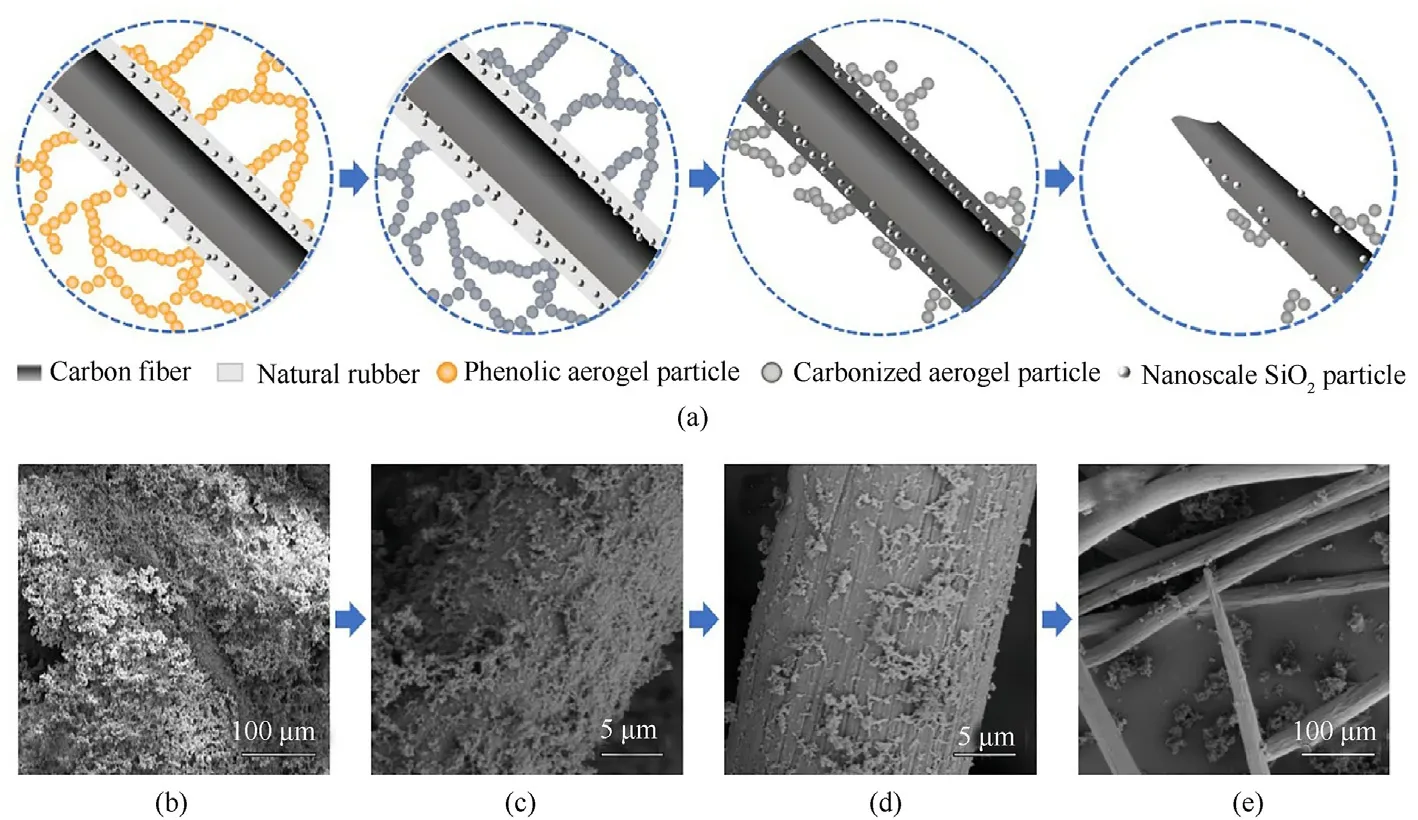
Fig.8.(a) Schematic illustration of the CFPA/SS ablation process; (b)-(e) Micromorphology of the representative CFPA/SS-2 sample with varying degrees of ablation.
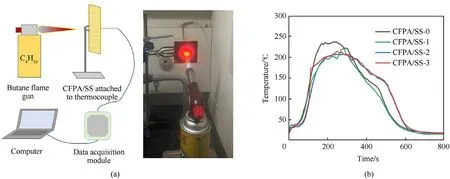
Fig.9.(a) Schematic illustration of long-time butane ablation test equipment; (b) Back-face temperature curves of CFPA/SS samples in the long-time butane ablation test.

Table 4Performance parameters of reported carbon-phenolic composites.
When exposed to a long-time ablation due to a low heat flux,carbon fibers in the composites can be more easily oxidized by the oxygen in high-temperature airflow, resulting in the performance degradation of composites to protect a spacecraft’s surface and internal structure.The long-term ablation resistance performance of CFPA/SS samples was evaluated in a butane flame at 1200°C for 200 s.As shown in Table 3, CFPA/SS-3 shows an insignificant recession with mass and linear ablation rates of 0.079 g/s and 0.039 mm/s, which has dropped largely by 16.84% and 13.33%,respectively,compared with CFPA/SS-0.The introduced nano-silica can effectively improve the anti-oxidation performance of CFPA in an oxidating environment with long-term low heat flux.
The long-term thermal insulation performance of CFPA/SS samples was also evaluated using a fixed thermocouple (Fig.9(a)).The back-face temperature curves of CFPA/SS samples in the long-term ablation test are illustrated in Fig.9(b).As is shown, the CFPA/SS-0 sample possesses the highest peak back-face temperature,236.7°C,while the ones of CFPA/SS-1,CFPA/SS-2,and CFPA/SS-3 are all distantly lower, which are 220.7°C, 207.7°C, and 213.5°C,respectively.Nano-silica modified CFPA can serve well as the TPS material in a long-time ablation under the condition of low heat flux.
To further identify the superiority of CFPA/SS for acting as TPS materials, a comparison with some other carbon/phenolic composites in previous reports (tested under oxyacetylene ablation conditions)is presented in Table 4.The main target of this study is to improve the ablative properties of lightweight CFPA with high toughness.Compared with other works, the obtained CFPA in our work exhibits better thermal insulation and ablation performance in the extremely high-temperature environment, as well as low density and high fracture strain.These indicate that nano-silica modified CFPA is an excellent candidate for the promising TPS material and may also be a good guidance to fabricating semiflexible or flexible TPS.
4.Conclusions
Silica sol prepared from TMOS with a small average particle size of 45 nm was employed as a modifier for CFPA.The nano-silica was then successfully introduced into the framework of CFPA by modifying the surface of the carbon fiber felt with silica sol/natural rubber coating, which remained attached to it in the ablation,and then it was integrated with the aerogel matrix.The resultant CFPA/SS possesses low density (0.28-0.31 g/cm3), high fracture strain(13.9%-31.2%), and excellent thermal conductivity(0.053-0.064 W/(m·K)).Moreover, owing to a trace amount of introduced nano-silica, which can effectively prevent the CFPA from erosion in a high-temperature oxidating environment, CFPA/SS showed improved ablative properties.In the oxyacetylene ablation test of 3000°C for 20 s,the mass and linear ablation rates of CFPA/SS greatly decreased, compared with CFPA/SS-0, by 9.64%and 24.82%.In the long-time butane ablation test of 1200°C for 200 s, CFPA/SS exhibited slight mass and linear ablation rate of 0.079 g/s and 0.039 mm/s, and peak back-face temperature distinctly decreased by 12.25%.According to the specific requirements of the production process and the flight mission, the overall performance of CFPA/SS can be adapted to different scenarios under different modification conditions.The lightweight and high-toughness nano-silica modified CFPA with excellent ablative properties are of great prospects in the applications of the aerospace field as the TPS material.
Declaration of competing interest
The authors declare that they have no known competing financial interests or personal relationships that could have appeared to influence the work reported in this paper.
Acknowledgements
This work was partly supported by the National Natural Science Foundation of China (Grant Nos.22178107, U21A2060, 22178116),Xinjiang Uygur Autonomous Region Key Research and Development Program (Grant No.2022B01030) and Shanghai Pujiang Program (Grant No.21PJD019).
Appendix A.Supplementary data
Supplementary data to this article can be found online at https://doi.org/10.1016/j.dt.2023.07.014.
- Defence Technology的其它文章
- The interaction between a shaped charge jet and a single moving plate
- Machine learning for predicting the outcome of terminal ballistics events
- Fabrication and characterization of multi-scale coated boron powders with improved combustion performance: A brief review
- Experimental research on the launching system of auxiliary charge with filter cartridge structure
- Dependence of impact regime boundaries on the initial temperatures of projectiles and targets
- Experimental and numerical study of hypervelocity impact damage on composite overwrapped pressure vessels

